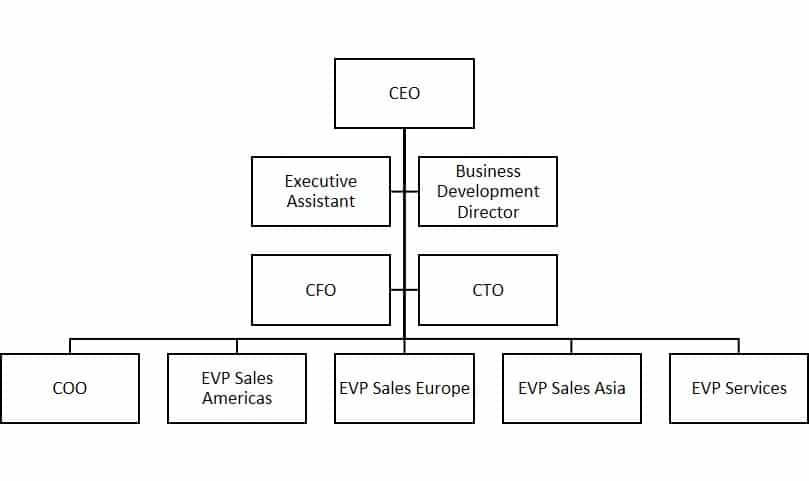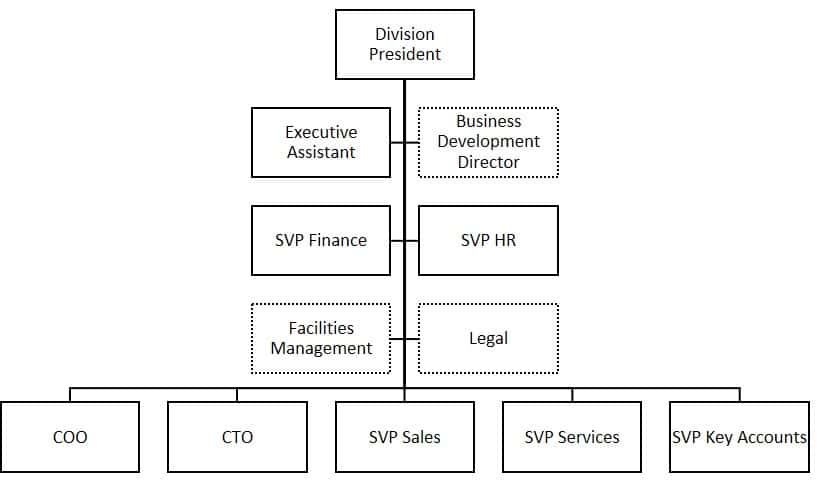A management team is a collection of top managers who set the strategy and run the operations of an organization together with its top leader. The management team can meet anywhere from weekly to monthly or quarterly, depending on the type of business and the team setup. It is normally structured around the direct reports of the top leader.
I will explain all aspects to you in more detail in this post, based on my experience of being a member of as well as the leader of several management teams over the years.
Leading a highly skilled team requires skill, experience, and proper use of leadership styles. I show you exactly how to do this in my democratic leadership course. I have also had great use of the Six Leadership Styles by Goleman when leading my team.
What is a management team?
The management team is the highest senior team of managers and leaders in an organization, including the top leader. It is not just a collection of top managers, but also a team whose results are leveraged by increased cooperation and teamwork encompassing all the different functions of the organization.
If you want to become a member of a management team someday, perhaps reading our article on how to create a leadership development plan for yourself could be a good idea.
What is the purpose of a management team?
Generally speaking, the purpose of the management team is to successfully operate the organization it is heading with all that that entails, as well as develop and execute a proper strategy for the future of the organization. The output of the team should also be more than the sum of the output of each of the individuals. If the management team can create this leverage, the organization will be stronger than each of its functions combined. This is the old “one plus one equals three” concept.
The different management team members are often heads of different functions, and the existence of the management team should also ensure that the different parts of the organization pull in the same direction. Depending on the type of organization, the following might also be included in the purpose of the management team:
- Creating and communicating a vision fitting to the strategy (read our article on visionary leadership style or transformational leadership for inspiration)
- Combining the efforts and plans of all the critical functions into the execution of the organization’s overarching plan and strategy.
- To ensure proper governance models and structures of the organization, some transactional and bureaucratic approaches might be needed.
- Risk analysis, risk assessment, and risk mitigation activities
- Monitoring external factors and reacting to those in a proper way in order to safeguard the organization for the future
You can learn about all the above-mentioned leadership styles in our styles portal available here: leadership styles. The portal also contains info on the situational leadership model. I do suggest you take a look at it for inspiration and development. It`s not easy to take the step from mid-level management to becoming a management team member or even the leader of a management team. These roles often require additional leadership skills and an understanding of strategic thinking. Democratic leadership is a good idea for a senior team from various functions, as it leads to engagement and empowerment through participation, which increases team performance substantially.
It is difficult to effectively and quickly tap into the creativity, collaboration, and drive of a senior team, but you can learn how to master this in my democratic leadership course, which contains tips, tricks, and implementation steps based on my vast experience as a CEO. Democratic leadership has truly helped me to succeed in my career, and I am positive it can work for you too.
How is a management team structured? Who are the members of a management team?
The member setup of a management team normally reflects the way the organization looks to a certain extent. They are often top managers of different functions, divisions, or business areas, depending on the level of the management team and the type of organization they work in. The team is headed by the top leader of the organization, i.e., a President, a CEO, a Managing Director, or similarly if it is in the world of business.
In a manufacturing business, you might have the senior leaders of sales, operations, logistics, HR, and finance in the management team. In a software startup, it might be the leaders of sales, marketing, software development, IT infrastructure, HR, and finance for instance. The member setup normally reflects the way the organization looks to a certain extent. They are often top managers of different functions, divisions, or business areas, depending on the level of a management team. It is crucial to create an atmosphere of trust and cooperation in any management team.
Note that not all people reporting to the top leader must be in the management team. Sometimes staff functions are not needed in the top decision forum but rather have an operational and advisory role on the side, for instance. Here are two examples of organizations and how the management team could be structured.
Management and organization structure example #1
In this case, the CEO has an Executive Assistant, a Business Development Director, a Chief Financial Officer, and a Chief Technical Officer shown as staff functions while the Chief of Operations, the head of Services, and three regional sales heads are listed more as operational units.
In this example, the CEO might choose to make all the direct reports part of the management team. See team structure example 1 below:

Example management team structure with staff members and leaders of larger functions. The organization chart equals the management team setup.
Management and organization structure example #2
The following example shows a Division organizational structure example. The Division President heads his team consisting of the following staff functions: Executive Assistant, a Business Development Director, SVP:s for Finance and HR, as well as legal and facilities managers. Chief of Operations, Chief Technology Officer, and three Senior Vice Presidents are listed as more operational functional areas.
In this example, legal, facilities, and BD have dotted boxes to signify that they are not part of the division management team. Perhaps facilities simply handle all the offices for the different locations and need to report to the President despite not having any operational duties. The BD and legal managers might be specialists called upon in special cases or for certain topics only. The remainder would form the management team that needs to run the company and set the strategy essentially.

Example Division management team structure with staff members and leaders of larger functions. Some direct reports are excluded from the management team.
There are tons of examples of how a management team could be structured. I will write a separate post on that sometime and drill deeper into that topic.
How often does a management team meet, and for how long?
The meeting frequency and length are up to the requirements and restrictions of each specific team. I have been in several national as well as international management teams, and I would say that the following is a pretty common setup:
- Monthly meetings of 1-1,5 days. In international teams, every other month is face-to-face, and the remaining would be via online communication tools. Sometimes these meetings are held off-site. When I have worked in companies with many offices, I have always tried to host meetings in different locations and use the office conference rooms. This will enable meeting the local staff and visiting makes them feel important in general, i.e., good for morale and motivation
- Weekly meetings for status updates, sharing of recent developments, sound boarding, etc. This would typically be a one-hour meeting. Any important topics identified can either be referred to the next management team meeting or be dealt with in a smaller group with a selection of members depending on the issue/topic.
- Quarterly reviews have been specifically aimed at geographical regions, areas, or functions and consist of a deep dive within that area. I would say that about half the management team would attend these depending on which area it is regarding. The meeting length would be 2-4 hours typically.
My democratic leadership course teaches you how to run effective team meetings, which lead to empowerment, accountability, and results.
For remote teams, use proper equipment so you can focus on the meeting and not get the sound to work. Additionally, if you are part of a remote management team, one of our articles might contain some good ideas: 6 Tips on how to host meetings in multiple time zones.
How can a management team be effective?
A management team should be empowered to lead the organization. The top leader might have a veto or a stronger say, but it is crucial that the management team is empowered to run the organization. (Read our article on why the leader should speak last for examples on why the leader should avoid taking all the decisions.) This level of empowerment creates a stronger sense of responsibility and accountability – two concepts that can genuinely improve the performance of the team. Furthermore, if the management team can serve this purpose, the organization is less dependent on the top leader. This increases efficiency and reduces the risk in case the top leader leaves for some reason. A leaderless organization with a strong empowered management team can continue to operate relatively smoothly for quite some time. Democratic Leadership, Transformational Leadership, or a combination of the Six Leadership Styles by Goleman can be very useful to create the necessary participation, empowerment, and accountability in the team. You do need elements of pacesetting as well of course, and I teach you the ins and outs of that style in my Pacesetting Leadership Blueprint, so that you also can get strong results without stressing the team unnecessarily.
During my career, I have seen many different versions of management teams. Some of them have been unsuccessful and hostile, and some of them have been effective and highly successful, leveraging the organization to a whole new level. Those topics can be expanded on a lot, so I will save it for future blog posts and will link to them from here once they are done. For inspiration, read our articles on leadership styles: An Autocratic leadership style often leads to a poor climate in the management team, the democratic or participative leadership style normally results in a good and effective climate. (All these approaches to leadership can be found here: leadership styles, make sure you check it out for inspiration.)
In conclusion, a management team’s purpose is to run the operational side of an organization as well as set and execute a proper strategy. It is normally structured around the direct reports of the top leader and meets weekly, monthly, or quarterly. A management team can be more effective if it is empowered to truly lead the organization with the top leader as one of the members rather than the ultimate conductor of everything.




